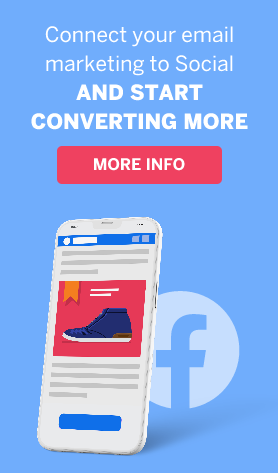Email Marketing Campaigns: 6 Ways to Boost Your Engagement
In this fast-paced world, you have to be able to communicate with your audience quickly and effectively. Your messages need to be engaging, attractive, and easy to skim and understand. They also have to be accessible from any device, from smartphone to desktop.
The best way to check off all of these boxes is to communicate with your audience through email. It’s quick, convenient, and personal. But to make the most of your email marketing strategy, you have to send emails that people want to read. With the right email marketing software, you can create a successful email marketing strategy and automatically optimize your activity as you go.
Top 6 Ways to Build a Successful Email Marketing Campaign and Boost Your Engagement:
1. Begin with a strong subject line
When your email arrives in someone’s inbox, you only get one chance to entice them in with your subject line. Piquing someone’s interest with the subject line is crucial to improving your open and click-through rates.
Your subject lines determine whether or not your subscribers open your emails, so follow some of these best practices to ensure that you’re maximizing your open rates:
-Keep your subject lines short. If they take too long to get to the point or are too long to be read in their entirety in the reader’s inbox, they’re not going to inspire the excitement they need to.
-Lead with a story. Humans are driven by stories, and if you tease the beginning of one in your subject line, your readers are going to want to find out how it ends.
-Make it fun. Whether it’s using emojis, referencing a beloved popular movie, or making a joke, using a light-hearted tone in your subject line (when appropriate) will make your reader feel good about receiving your communications and want to read your emails.
When you start off strong with an engaging and interesting subject line, you have a better chance of increasing conversions for your organization, whatever a conversion may be for you.
Does your organization’s software solution allow you to track metrics from your email campaigns? Read Fonteva’s membership software guide to learn more about how your software should enable you to make better data-driven decisions.
2. Segment your contact list
It’s hard to write an email that works for everyone in your target audience. Your audience is made up of all kinds of people who are drawn to your organization through different factors. In order to take advantage of these differences, you have to know your audience.
When you know specific information about your audiences, such as their geographic location, age, gender, industry, marital status, or anything else, you can send more relevant emails to them. Relevant or targeted emails get higher open rates, which increases your click-through and conversion rates.
Population segmentation relies on useful, actionable data. How much do you know about your contacts? And where are you storing that information? The first step to a segmentation strategy is a robust CRM, or customer relationship management system. In software like this, you can keep track of every purchase or interaction a contact has with your organization.
No matter if you’re using a major CRM like Salesforce or a more targeted software solution like an association management system, it should give you the opportunity to create reliable and informational profiles.
Here are segments you can use:
-Contact information, like an email or home address and phone number.
-Demographic information, like gender, age, or occupation.
-Engagement information, like purchases, event attendance, or subscriptions.
Then, you can use this information to build groups of similar individuals. Young and single professionals, for example, will be attracted to different things than married retirees. People of different generational groups are swayed by different marketing techniques.
If you don’t know anything about your contacts, don’t be afraid to just ask them! Send out surveys or ask them while they explore your webpage.
While it may seem like more work to write emails for different segments, it will pay off in the long run when your contacts respond better to more personalized messaging.
3. Personalize your email marketing
Now that you know who will be receiving your emails, it’s time to figure out what you’re going to say. The key to a strong email is to make it personal by incorporating your subscribers’ interests and relationships.
The first step in personalization is to use your contacts’ names wherever you can.
Instead of addressing your readers as “Dear Valued Customer” or something similarly vague, open your emails with “Dear Alexa” or “Good morning, John.” Try sprinkling their name through the copy of your email, like, “We couldn’t have done it without you, Mark.”
Next, consider including their previous engagement with your organization in your copy.
By reminding them of how much they enjoyed their last experience and demonstrating your appreciation for their involvement, you can inspire them to remain interested in your organization.
Consider some of the following ways to show that you’ve been paying attention:
-“We hope you had a great time at our event in Augusta this summer!”
-“How are you enjoying your new [insert purchase]?”
-“Thank you again for using our t-shirt templates last week. Your support helped us to…”
Finally, don’t forget to use what you know about their interests to send them more information that they may find intriguing.
For example, if someone has purchased camping gear from your organization, send them blog posts on your website that are about national parks, camping, or conservation. The style of this strategy will vary based on what type of organization you are, but it works for everyone!
4. Use visual storytelling
No matter how engaging your copy is, if your emails aren’t visually appealing to the reader they aren’t going to be as interested as they could be. When planning out how to send your emails, use rich media like pictures and videos to really get your readers’ attention. You can choose one of our designed newsletter templates as well.
Visual storytelling is a strategy used for all types of communications: marketing emails, fundraising letters, and commercials. Your organization can benefit from the use of visual storytelling by using images to supplement the copy of your emails.
The best types of images and videos to include are:
-High-quality. Professional-looking photos and videos are going to grab a reader’s attention far more than a blurry, dark, or overexposed photo will.
-People-centric. A picture of a mountain might be nice, but a better call-to-action for your organization’s product would be a group of people standing on a mountain, using or wearing your products. It uses the fear of missing out, or FOMO, to make your product seem more appealing.
-Appropriately sized. Your photos and videos should fit naturally into your emails, without flooding over the text or out of frame. This is especially important for emails opened on a mobile device because if your images are the wrong size they’ll block your text entirely.
Visual storytelling is a valuable engagement tool for email marketing campaigns because it snags the reader’s gaze more readily than copy alone can.
If you draw a reader in with a high-quality visual, they’ll be more likely to read the copy than they will if they open an email and just see a wall of text.
5. Optimize everything for mobile
We mentioned this briefly in the last section, but this engagement strategy is important enough that it deserves its time in the spotlight. More and more people are accessing their email primarily through their smartphones.
In fact, 73% of people ages 35 and up check their email on their smartphones more than they do on a laptop or tablet! If you want your email marketing campaign to really take off, you need to meet your community where they are.
In order to send the best emails possible, make sure that your emails are mobile-responsive and easy to read. Some best practices for sending mobile-friendly emails are:
-Including inline images, instead of attached images. They’ll load as part of the email instead of requiring an action from the reader.
-Use bold call-to-action buttons instead of hyperlinks. Small links can be difficult to find and click on a phone screen, so make it as easy as possible for the reader by including easy to see buttons.
-Use a single-column layout. A single column will always be readable, as opposed to a dual column setup. Two columns can lead to font too tiny to read or one of the columns getting pushed out of frame.
Creating mobile-friendly emails isn’t difficult, and it’s vital for your marketing campaigns. Always test and double-test that your emails open properly on mobile before sending them out to your contact list.
6. Strengthen your landing pages
So you’ve written the perfect email: it’s engaging, interesting, pretty, and mobile-responsive. Your reader decides that they’re interested in what you have to say, and then click on your big, easy-to-find button to go to whatever page you’ve offered to them.
Are you ready for your readers to land on your pages? The last step in creating an engaging email marketing campaign is to create the best landing page that you can.
No matter if you’re trying to get contacts to fill out a survey or register for an event, all your hard work will have been for nothing if your contacts don’t like the landing page. Shopping cart abandonment, or when readers begin but don’t complete a form, is an issue for organizations of all industries
To ensure that your landing page is up to par and to minimize abandonment, follow some of our favorite best practices:
-Reduce the number of fields required to complete the page. If you want someone to register for a webinar, don’t require them to fill out fields and fields of information irrelevant to the webinar.
-Simplify your design. Clean, bold colors and text, along with easy-to-use buttons will improve your conversion rate.
-Add contact information. Not all subscribers will convert on the first visit to your landing page, so give them options to remain in touch in the hopes of converting them later.
A good email marketing campaign ends with contacts converting on a landing page, so make sure you put as much effort into your landing page as you go into your emails!
Guest Author:
Jake Fabbri is the Vice President of Marketing at Fonteva with over 18 years of experience working in marketing management. He has experience with lead generation, content marketing, marketing automation, and event.
Read more:
7 Ways to Boost Your Events With Smarter Email Marketing
6 Marketing Automation Mistakes E-commerce Businesses Must Avoid







